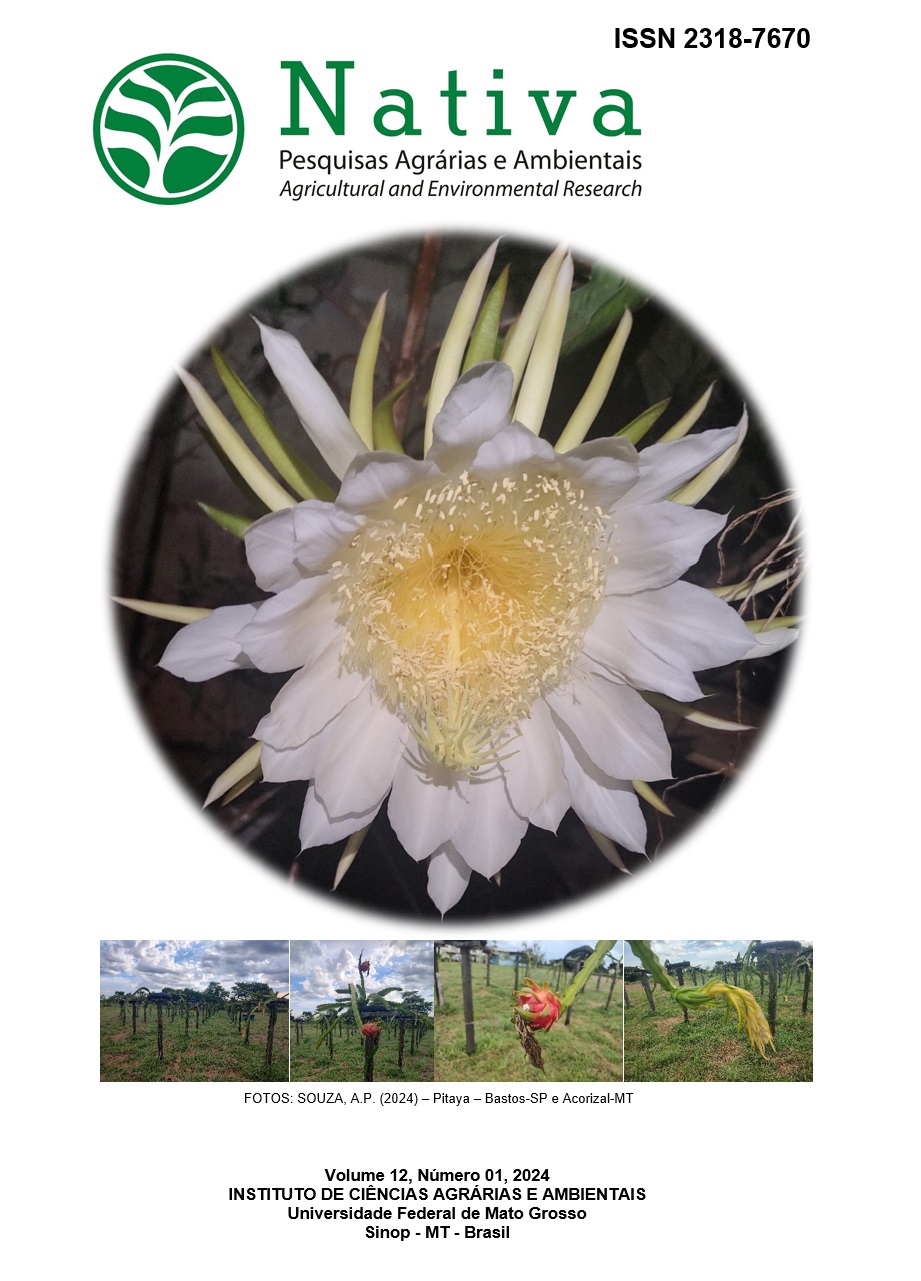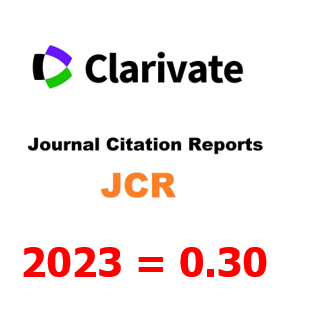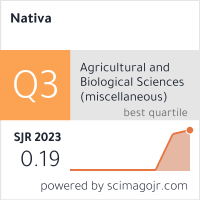EDAPHIC MITE COMMUNITY IN DIFFERENT LAND USES
DOI:
https://doi.org/10.31413/nat.v12i1.16897Palavras-chave:
agroecosystem, agroforestry systems, Cerrado, species richness, organic matterResumo
Soil mites play an essential role in the fragmentation of organic material, which facilitates the decomposition process by microorganisms and subsequent promotion of soil fertility, play an indispensable role in the trophic chain, and can be influenced by different soil uses. More structured and stable systems tend to have more extraordinary richness and abundance of edaphic mites. In this study, the influence of three agroecosystems types with differences in land use (agroforestry system, native vegetation, pasture) were compared concerning their edaphic mite communities. A nonparametric test was later performed to analyze the difference in the abundance and richness of agroecosystems. Thirty-one morphospecies of mites and 117 individuals were found. The highest abundance of edaphic mites was observed in agroforestry systems, and the more incredible richness of edaphic mites was observed in native vegetation. Thus, we conclude that the mite community presents itself as a soil indicator, reflecting both soil parameters and changes in use and management.
Keywords: agroecosystem; agroforestry systems; Cerrado; Species richness; organic matter.
Comunidade de ácaros edáficos em diferentes usos do solo
RESUMO: Os ácaros do solo desempenham um papel importante na fragmentação do material orgânico, o que facilita o processo de decomposição por microrganismos e a subsequente promoção da fertilidade do solo, desempenhando um papel importante na cadeia trófica e podendo ser influenciados por diferentes usos da terra. Sistemas mais estruturados e estáveis tendem a apresentar maior riqueza e abundância de ácaros edáficos. Neste estudo, a influência de três tipos de agroecossistemas com diferenças no uso da terra (sistema agroflorestal, vegetação nativa, pastagem) foi comparada em relação às suas comunidades de ácaros edáficos. Posteriormente, foi realizado um teste não paramétrico para analisar a diferença na abundância e riqueza dos agroecossistemas. Foram encontradas 31 morfoespécies de ácaros e 117 indivíduos. A maior abundância de ácaros edáficos foi observada nos sistemas agroflorestais, e a maior riqueza de ácaros edáficos foi observada na vegetação nativa. Assim, concluímos que a comunidade de ácaro se apresenta como indicadores de solo, refletindo tanto os parâmetros do solo quanto as alterações de uso e manejo.
Palavras-chave: agroecossistema; sistemas agroflorestais; Cerrado; riqueza de espécies; matéria orgânica.
Referências
ALTIERI, M. Agroecologia: bases científicas para uma agricultura sustentável. Expressão popular, 2012. 400p. https://expressaopopular.com.br/livraria/agroecologia-bases-cientificas-para-uma-agricultura-sustentavel/
ARROYO, J.; ITURRONDOBEITIA, J. C. Differences in the diversity of oribatid mite communities in forests and agroecosystems. European Journal of Soil Biology, v. 42, p. 259-269, 2006. https://doi.org/10.1016/j.ejsobi.2006.01.002
BALOGH. P.; GERGÓCS, V.; FARKAS, E.; FARKAS P.; KOCSIS, M.; HUFNAGEL, L. Oribatid assemblies of tropical high mountains on some points of the Gondwana-bridge – a case study. Applied Ecology And Environmental Research, v. 6, n. 3, p. 127-158, 2008.
BARETTA, D.; ALVES, M. V.; CARDOSO, E. J. B. M. Fauna edáfica em diferentes sistemas de cultivo no Estado de São Paulo. Revista de Ciências Agroveterinárias, v. 5, n. 1, p. 33-43, 2006.
BARETTA, D.; SANTOS, J. C.; SEGAT, J.C.; GEREMIA, E. V.; OLIVEIRA FILHO, L. D.; ALVES, M. V. Fauna edáfica e qualidade do solo. Tópicos em Ciência do Solo, v. 7, p. 119-70, 2011.
BARTZ, M. L.; BROWN, G. G.; ORSO, R.; MAFRA, Á. L.; BARETTA, D. The influence of land use systems on soil and surface litter fauna in the western region of Santa Catarina. Revista de Ciências Agroveterinárias, v. 45, n. 5, p. 880-887, 2014. https://doi.org/10.1590/S1806-66902014000500003
BEDANO, J. C.; CANTU, M. P.; DOUCET, M. E. Influence of three different land management practices on soil mite (Arachnida: Acari) densities about a natural soil. Applied Soil Ecology, v. 32, n. 3, p. 293-304, 2006. https://doi.org/10.1016/j.apsoil.2005.07.009
BEHAN-PELLETIER, V. M. Oribatid mite biodiversity in agroecosystems: role for bioindication. Agriculture, Ecosystems & Environment, v. 74, n. 1-3, p. 411-423, 1999. https://doi.org/10.1016/S0167-8809(99)00046-8
BROWN, G. G.; NIVA, C. C.; ZAGATTO, M. R. G.; FERREIRA, S. A.; NADOLNY, H. S.; CARDOSO, G. B. X.; SANTOS, A.; MARTINEZ, G. A.; PASINI, A.; BARTZ, M. L. C.; SAUTTER, K. D.; THOMAZINI, M. J.; BARETTA, D.; SILVA, E.; ANTONIOLLI, Z. I.; DECAËNS, T.; LAVELLE, P. M.; SOUSA, J. P.; CARVALHO, F. Biodiversidade da fauna do solo e sua contribuição para os serviços ambientais. In: JUNIOR, R. G.; OLIVEIRA, E. B.; BROWN, G. G.; PRADO, R. B. Serviços ambientais em sistemas agrícolas e florestais do Bioma Mata Atlântica. Brasília, DF: Embrapa, 2015. 121-154p.
CANELLAS, L. P.; VELLOSO, A. C. X.; MARCIANO, C. R.; RAMALHO, J. F. G. P.; RUMJANEK, V. M.; REZENDE, C. E.; SANTOS, G. D. A. Propriedades químicas de um Cambissolo cultivado com cana-de-açúcar, com preservação do palhiço e adição de vinhaça por longo tempo. Revista Brasileira de Ciência do Solo, v. 27, n. 5, p. 935-944, 2003. https://doi.org/10.1590/S0100-06832003000500018
CECCONI, M.; RUSSO, G. Prediction of soil-water retention properties of a lime stabilised compacted silt. In: TOLL, D. C.; AUGARDE, C. E.; GALLIPOLI, D.; WHEELER, S. J. Unsaturated Soils: Advance in Geo-Engineering. London: Taylor & Francis Group, 2015. p. 271-276.
CLAPPERTON, M. J.; KANASHIRO, D. A.; BEHAN-PELLETIER, V. M. Changes in abundance and diversity of microarthropods associated with Fescue Prairie grazing regimes. Pedology, v. 46, n. 5, p. 496-511, 2002. https://doi.org/10.1078/0031-4056-00155
CONNELL, J. H. Diversity in Tropical Rain Forests and Coral Reefs. Science, v. 199, p. 1302-1310, 1978. https://doi.org/10.1126/science.199.4335.1302
DHOORIA, M. S. Soil mites. Fundamentals of Applied Acarology. Singapura: Springer, 2016. p. 197-206. https://doi.org/10.1007/978-981-10-1594-6_10
DOLLINGER, J.; JOSE, S. Agroforestry for soil health. Agroforestry Systems, v. 92, p. 213-219, 2016. https://doi.org/10.1007/s10457-018-0223-9
EMBRAPA_Empresa Brasileira de Pesquisa Agropecuária. Manual de métodos de análises de solos. Rio de Janeiro: Embrapa, 2011. 212p.
FAGAN, L. L.; DIDHAM, R. K.; WINCHESTER, N. N.; BEHAN-PELLETIER, V.; CLAYTON, M.; LINDQUIST, E.; RING, R. A. An experimental assessment of biodiversity and species turnover in terrestrial vs canopy leaf litter. Oecology, v. 147, p. 335-347, 2006. https://doi.org/10.1007/s00442-005-0262-6
FERREIRA, F. G.; MACHADO, E. L. M.; SILVA-NETO, C. M.; SILVA-JUNIOR, M. C.; MEDEIROS, M. M.; GONZAGA, A. P. D.; SOLORZANO, A.; VENTUROLI, F.; FELFILI-FAGG, J. M. Diversity, indicator species in the Cerrado Biome, Brazil. Australian Journal of Crop Science, v. 11, p. 1042-1050, 2017. https://doi.org/10.21475/ajcs17.11.08.pne615
FILGUEIRAS, T. S.; BROCHADO, A. L.; NOGUEIRA, P.; GUALA, G. F.; FILGUEIRAS, T. S.; PINEDO-BROCHADO, A.; NOGUEIRA, P. G. Caminhamento - Um método expedito para levantamentos florísticos qualitativos. Caderno de Geociências, v. 12, p. 39-43, 1994.
HANSEN, R. A. Effects of habitat complexity, composition on a diverse litter microarthropod assemblage. Ecology, v. 81, p. 1120-1132, 2000. https://doi.org/10.2307/177183
JOHN, M. G. S.; WALL, D. H.; HUNT, H. W. Are soil mite assemblages structured by the identity of native and invasive alien grasses? Ecology, v. 87, p. 1314-1324, 2006. https://doi.org/10.1890/0012-9658(2006)87[1314:asmasb]2.0.co;2
JOSCHKO, M.; FOX, C. A.; LENTZSCH, P.; KIESEL, J.; HIEROLD, W.; KRÜCK, S.; TIMMER, J. Spatial analysis of earthworm biodiversity at the regional scale. Agriculture, Ecosystems & Environment, v. 112, n. 4, p. 367-380, 2006. https://doi.org/10.1016/j.agee.2005.08.026
KARYANTO, A.; RAHMADI, C.; FRANKLIN, E.; MORAIS, J. W. Soil Collembola, Acari and other mesofauna—the Berlese method. In: MOREIRA, F. M. S.; HUISING, E. J.; BIGNALL, D. E. A handbook of tropical soil biology: sampling and characterization of below-ground biodiversity. London: Earth, 2008. p. 85-94.
KRANTZ, G. W.; WALTER, D. E. A manual of Acarology. Lubbock: Texas Tech University Press, 2009. 807p.
LAVELLE, P.; SPAIN, A. V. Soil ecology. Dordrecht: Kluwer Academic Publishers, 2001. 654p.
LEGENDRE, P.; LEGENDRE, L. Numerical ecology: second English edition. Developments in environmental modeling. Amsterdam: Elsevier, 2005. 853p.
LIIRI, M.; HAIMI, J.; SETÄLÄ, H. Community composition of soil microarthropods of acid forest soils as affected by wood ash application. Pedobiologia, v. 46, n. 2, p. 108-124, 2002. https://doi.org/10.1078/0031-4056-00118
LUIZÃO, R. C.; LUIZÃO, F. J.; PAIVA, R. Q.; MONTEIRO, T. F.; SOUSA, L. S.; KRUIJT, B. Variation of carbono and nitrogen cycling processes along a topographic gradient in a central Amazonian Forest. Global Change Biology, v. 10, n. 5, p. 592-600, 2004. https://doi.org/10.1111/j.1529-8817.2003.00757.x
MARIBIE, C. W.; NYAMASYO, G. H. N.; NDEGWA, P. N.; MUNG'ATU, J. K.; LAGERLOF, J.; GIKUNGU, M. Abundance, diversity of soil mites (acari) along a gradient of l, use types in taita taveta, Kenya. Tropical and Subtropical Agroecosystems, v. 13, p. 11-27, 2011.
MINOR, M. A.; CIANCIOLO, J. M. Diversity of soil mites (Acari: Oribatida, Mesostigmata) along a gradient of l, use types in New York. Applied Soil Ecology, v. 35, n. 1, p. 140-153, 2007. https://doi.org/10.1016/j.apsoil.2006.05.004
MOÇO, M. K. S.; GAMA-RODRIGUES, E. F.; GAMA-RODRIGUES, A. C.; MACHADO, R. C.; BALIGAR, V. C. Relationships between invertebrate communities, litter quality, soil attributes under different cacao agroforestry systems in the south of Bahia, Brazil. Applied Soil Ecology, v. 46, n. 3, p. 347-354, 2010. https://doi.org/10.1016/j.apsoil.2010.10.006
MORAES, G.; FLECHTMANN, C. H. W. Manual de acarologia. Acarologia básica e ácaros de plantas cultivadas no Brasil. Ribeirão Preto: Esalq, 2008. 308p.
NAIR, P. K. R.; KUMAR, B. M.; NAIR, D. V.D. Agroforestry as a strategy for carbon sequestration. Journal of Plant Nutrition and Soil Science, v. 172, n. 1, p. 10-23, 2009. https://doi.org/10.1002/jpln.200800030
OSLER, G. H.; MURPHY, D. V. Oribatid mite species richness, soil organic matter fractions in agricultural and native vegetation soils in Western Australia. Applied Soil Ecology, v. 29, p. 93-98, 2005. https://doi.org/10.1016/j.apsoil.2004.09.002
PARSI, Z.; HARTOG, N.; GÓRECKI, T.; POERSCHMANN, J. Analytical pyrolysis as a tool for the characterization of natural organic matter - A comparison of different approaches. Journal of Analytical and Applied Pyrolysis, v. 79, n. 1-2, p. 9-15, 2007. https://doi.org/10.1016/j.jaap.2006.10.013
POMPEO, P. N.; OLIVEIRA FILHO, L. C. I.; FILHO, O. K.; MAFRA, A. L.; BARETTA, C. R. D. M.; BARETTA D. Diversidade de Coleoptera (Arthropoda: Insecta) e atributos edáficos em sistemas de uso do solo no Planalto Catarinense. Scientia Agraria, v. 17, p. 16-28, 2016. https://doi.org/10.5380/rsa.v17i1.46726
RAMOS, T. V.; SANTOS, L. A. C.; SOUZA, W. G.; SOUZA, K. R.; LIMA, N. L.; GUIMARAES, L. E.; SILVA-NETO, C. M. Chemical attributes of Brazilian Cerrado soil under different management systems. Australian Journal of Crop Science, v. 12, n. 3, p. 505-510, 2018. https://doi.org/10.21475/ajcs.18.12.03.pne1126
RODRIGUES, E. R.; CULLEN-JÚNIOR, L.; BELTRAME, T. P.; MOSCOGLIATO, A. V.; SILVA, I. C. Avaliação econômica de sistemas agroflorestais implantados para recuperação de reserva legal no Pontal do Paranapanema, São Paulo. Revista Árvore, v. 31, n. 5, p. 941-8, 2007. https://doi.org/10.1590/S0100-67622007000500018
ROVEDDER, A. P.; ANTONIOLLI, Z. I.; SPAGNOLLO, E.; VENTURINI, S. F. Fauna edáfica em solo suscetível à arenização na região sudoeste do Rio Grande do Sul. Revista de Ciências Agroveterinárias, v. 3, n. 2, p. 87-96, 2004.
SALTON, J. C.; MIELNICZUK, J.; BAYER, C.; BOENI, M.; CONCEIÇÃO, P. C.; FABRÍCIO, A. C.; MACEDO, M. C. M.; BROCH, D. L. Agregação e estabilidade de agregados do solo em sistemas agropecuários em Mato Grosso do Sul. Revista Brasileira de Ciência do Solo, v.32, p. 11-21, 2008. https://doi.org/10.1590/S0100-06832008000100002
SANTOS, E. M. R.; FRANKIN, E.; MAGNUSSON, W. E. Cost-efficiency of a sub sampling protocols to evaluate oribatid-mite communities in a Amazonian savanna. Biotropica, v. 40, p. 728-735, 2008. https://doi.org/10.1111/j.1744-7429.2008.00425.x
SHARMA, N.; PARWEZ, H. Population density and diversity of Soil mites (Order: acarina) in agroforestry habitat: Relationship to Soil temperature and Soil moisture. International Journal of Applied Environmental Sciences, v. 12, n. 3, p. 1449-1460, 2017.
SIMPSON, J. E.; SLADE, E.; RIUTTA, T.; TAYLOR, M. E. Factors affecting soil fauna feeding activity in a fragmented lowland, temperate deciduous woodland. Plos One, v. 7, n. 1, 1-6, 2012. https://doi.org/ 10.1371/journal.pone.0029616
STÖCKER, C. M.; BAMBERG, A. L.; STUMPF, L.; MONTEIRO, A. B.; CARDOSO, J. H.; LIMA, A. C. R. Short-term soil physical quality improvements promoted by an agroforestry system. Agroforestry Systems, v. 94, p. 2053-2064, 2020. https://doi.org/10.1007/s10457-020-00524-3
ZAGO, L.; FERREIRA, M. E.; CARAMORI, S. S.; MOREIRA, A. K.; SILVA-NETO, C. M.; NABOUT, J. C. Biochemical activity in Brazilian Cerrado soils is differentially affected by perennial and annual crops. Australian Journal of Crop Science, v. 12, n. 2, p. 235-242, 2018. https://doi.org/10.21475/ajcs.18.12.02.pne716
Downloads
Publicado
Edição
Seção
Como Citar
Licença
Copyright (c) 2024 Nativa

Este trabalho está licenciado sob uma licença Creative Commons Attribution-NonCommercial 4.0 International License.
Direitos Autorais para artigos publicados nesta revista são do autor, com direitos de primeira publicação para a revista. Em virtude de a aparecerem nesta revista de acesso público, os artigos são de uso gratuito, com atribuições próprias, em aplicações educacionais e não-comerciais.
A artigos publicados nessa revista, podem ser reproduzidos parcialmente ou utilizados como referência por outros autores, desde que seja cita a fonte, ou seja, a Revista Nativa.
Copyright for articles published in this journal are the authors, with first publication rights granted to the journal. The journal shows open access, and articles are free to use, with proper attribution, in educational and non-commercial.
The articles published in this journal may be reproduced in part or used as a reference by other authors, provided that the source is quoted.






